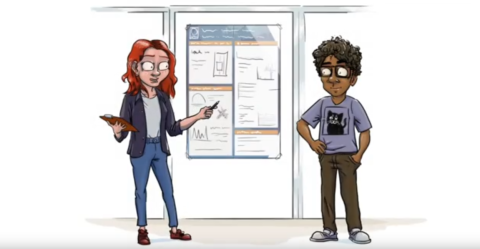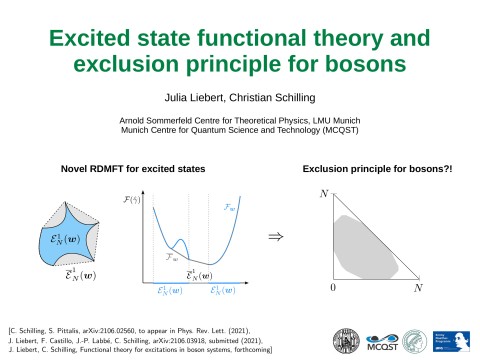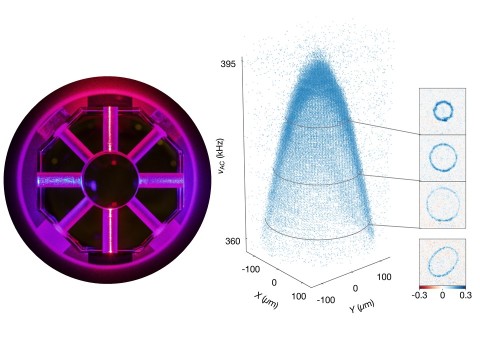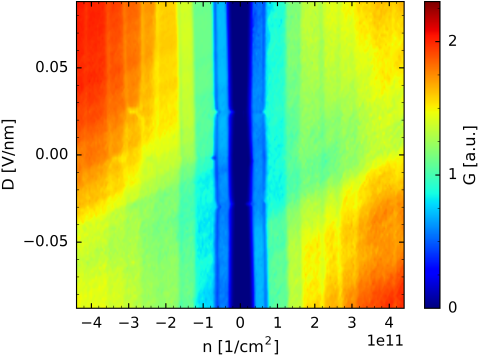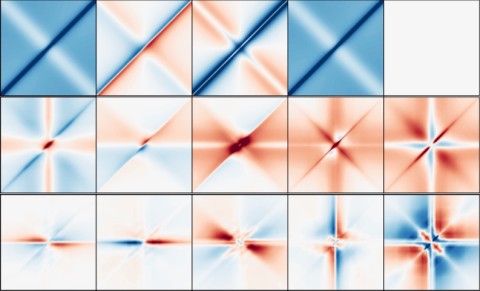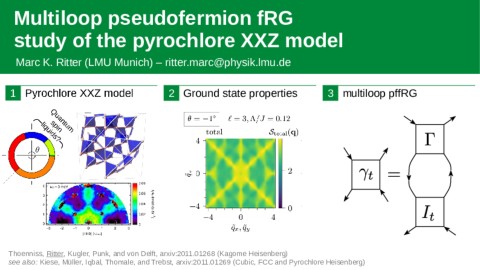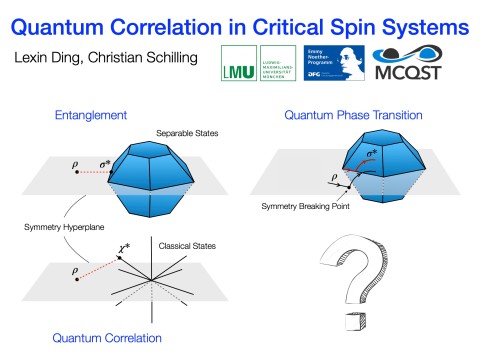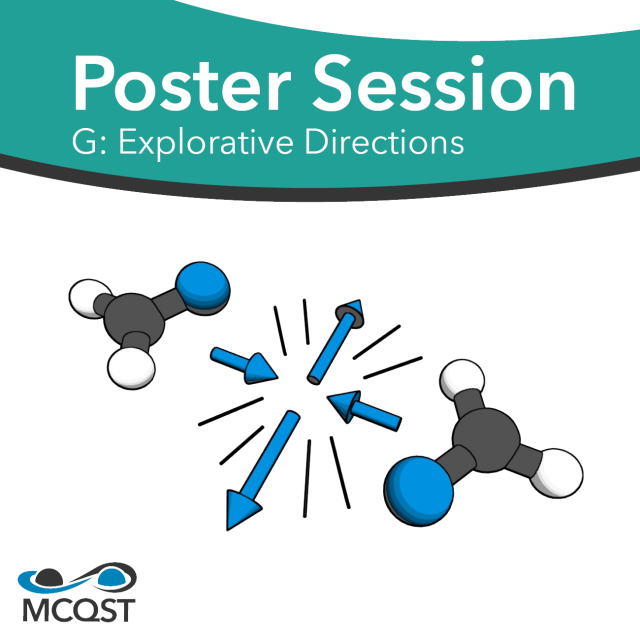
G. Explorative Directions
Poster Session I | All posters are presenting
Monday, 19 July 18:00 - 19:30 CEST
Poster Session II | All posters are presenting
Wednesday, 21 July 11:00 - 12:30 CEST
G.1 Matheus Araújo
Universidade Federal do Oeste da Bahia
Abstract
Thermodynamics of the Rabi Oscillation produced by an adiabatic pulse
Quantum thermodynamics is a novel research field that seeks to extend thermodynamics and statistical physics concepts to describe physical systems whose dimension is far below the classical thermodynamic limits by including quantum fluctuations and establishing fundamental relationships between nonequilibrium statistical-mechanics and quantum information theory[1-3]. In this context, we present a study of the fundamentals and applications of quantum thermodynamics, analyzing Rabi oscillations in a two-level atom interacting with a classical electromagnetic field[4,5]. Our results show the energetic contribution of an adiabatic pulse on the genuinely quantum thermodynamic processes, analyzing its thermal fluctuations of Rabi’s oscillations. Our results are useful in different scientific areas since two-level models are a ubiquitous approximation for several physical systems. Therefore, the present approach brings a new perspective on harnessing two-level systems applications in emerging quantum technologies based on quantum thermodynamic processes.(3,6) 1. Michael A. Nielsen, Isaac L. Chuang, Quantum Computation and Quantum Information 2.Deffner, Sebastian and Campbell, Steve. Quantum Thermodynamics 3.Unraveling the role of coherence in the first law of quantum thermodynamics., Bernardo, Bertúlio de Lima., Phys. Rev. E., 102 (2020) 062152 4. M. O. Scully and M. S. Zubairy. Quantum Optics. 5.Wolfgang P. Schleich: Quantum optics in phase space 6.Anatoly A. Svidzinsky, Hichem Eleuch, and Marlan O. Scully, ”Rabi oscillations produced by adiabatic pulse due to initial atomic coherence,”Opt. Lett. 42, 65-68 (2017)
Centro de Ciências Exatas e das Tecnologias, Universidade Federal do Oeste da Bahia. Rua Bertioga, 892, Morada Nobre I, 47810-059 Barreiras, Bahia, Brazil.
Matheus Araújo(1) , C. Cruz(1)
G.2 Julia Liebert
LMU Munich
Abstract
Excited state functional theory and exclusion principle for bosons
We propose and initiate a one-particle reduced density matrix functional theory (RDMFT) for targeting excitation energies of bosonic quantum systems. In analogy to its recently established fermionic counterpart, this bosonic w-ensemble RDMFT is based on a generalization of the Rayleigh-Ritz variational principle to ensemble states with spectrum w used within the constrained search formalism. Most importantly, an exact convex relaxation is implemented to turn w-ensemble RDMFT into a practically feasibly method: The corresponding convex-relaxed 1-body w-ensemble N-representability problem can be solved, revealing a complete hierarchy of exclusion principle constraints in analogy to Pauli’s famous principle for fermions.
Authors: Julia Liebert (1,2), Christian Schilling (1,2)
Affiliations: (1) Arnold Sommerfeld Centre for Theoretical Physics, LMU Munich (2) Munich Centre for Quantum Science and Technology (MCQST)
G.3 Fabian Schmid
Max Planck Institute of Quantum Optics
Abstract
Towards High-Precision Spectroscopy of the 1S-2S Transition in He+
Precise tests of a physical theory require a system whose properties can be both measured and calculated with very high precision. One famous example is the hydrogen atom which can be precisely described by bound-state quantum electrodynamics (QED) and whose transition frequencies can be accurately measured by laser spectroscopy. Two fundamental constants, the Rydberg constant and the nuclear charge radius, are determined by fitting the theory expression for the energy levels to the experimental data. Comparing the fundamental constants extracted from different combinations of measurements then serves as a consistency check for the theory itself. We are currently setting up an experiment to perform spectroscopy on the 1S-2S transition in the simplest hydrogen-like ion, He+. By combining the 1S-2S transition frequency with an accurate value of the helium nuclear charge radius measured by muonic helium spectroscopy, we will be able to make an independent determination of the Rydberg constant. This value will then be compared with the value obtained from hydrogen spectroscopy, serving as one of the most stringent tests of QED. Due to their charge, He+ ions can be held near-motionless in the field-free environment of a Paul trap, providing ideal conditions for a high precision measurement. Furthermore, interesting higher-order QED corrections scale with large exponents of the nuclear charge, which makes this measurement much more sensitive to these corrections compared to the hydrogen case. The main challenge of the experiment is that driving the 1S-2S transition in He+ requires narrow-band radiation at 61 nm. This lies in the extreme ultraviolet (XUV) spectral range where no transparent solids and no cw laser sources exist. Our approach is to use two-photon direct frequency comb spectroscopy with an XUV frequency comb. The comb is generated from an infrared high power frequency comb using intracavity high harmonic generation. The spectroscopy target will be a small number of He+ ions which are trapped in a linear Paul trap and sympathetically cooled by co-trapped Be+ ions.
Authors: Fabian Schmid (1), Akira Ozawa (1), Johannes Weitenberg (1), Theodor W. Hänsch (1, 2), and Thomas Udem (1, 2)
Affiliations: (1) Max Planck Institute of Quantum Optics, Garching, Germany (2) Ludwig Maximilian University, Munich, Germany
G.4 Elisabeth Wybo
TU Munich
Abstract
Entanglement Characteristics of Quasiparticles in 1D
The entanglement of many-body systems encodes information about the underlying quantum phases. While the entanglement structure of the ground state has been widely explored, much less is known for the quasiparticle (QP) excitation at low energy. We show how to distinguish different phases via the entanglement structure in the low energy QPs.
Authors: Elisabeth Wybo (1), Frank Pollmann (1), S.L. Sondhi (2), Yizhi You (2)
Affiliations: (1) Department of Physics, TUM, James-Franck-Strasse 1, D-85748 Garching, Germany (2) Department of Physics, Princeton University, NJ 08544, USA
G.5 Valentin Klüsener
Abstract
Towards Quantum Simulation of Light-Matter Interfaces with Strontium Atoms in Optical Lattices
Quantum simulators based on ultracold atoms in optical lattices are renowned for their success in emulating strongly correlated condensed matter systems. In addition, recent theoretical proposals show that the high degree of controllability of these simulators also enables emulating strongly-coupled light-matter-interfaces in parameter regimes that are unattainable in real photonic systems. To realize these exciting proposals, the integration and development of experimental tools are necessary. Towards this goal, we have developed in-vacuum, monolithic build-up cavities which will be used to increase the system sizes in quantum gas microscopes by an order of magnitude compared to the state-of-the-art, improve the lattice homogeneity, and enhance the lattice depth. These advantages will reduce finite size effects and allow implementing state-dependent lattices, which are a key ingredient to the aforementioned proposals. To benchmark the size and homogeneity of the lattices created in these cavities, we image their intensity profile using clock spectroscopy. Although our efforts for the cavities are focused on quantum simulation, our results present a viable solution to create ultracold atoms experiments where compactness, stability, and large, deep lattices can be achieved simultaneously.
Authors: Valentin Klüsener (1), Annie Jihyun Park (1), Jan Trautmann (1), Dimitry Yankelev (1), Yilong Yang (1), Dimitrios Tsevas (1), Immanuel Bloch (1,2) and Sebastian Blatt (1)
Affiliations: (1) Max-Planck-Institut für Quantenoptik, Hans-Kopfermann-Straße 1, 85748 Garching, Germany (2) LMU, Schellingstraße 4, 80799 München, Germany
G.6 Katja Barthelmi
Walter Schottky Institute / TU Munich
Abstract
Gate-tunable single photon emitters site-selectively generated in monolayer MoS2
Controlling single-photon emission on a few nanometers plays an important role for the scalability of future quantum photonic circuits. Moreover, it is highly relevant to facilitate a gate-switchable emission for quantum information schemes. By irradiating MoS2 with helium ions, we generate single-photon sources with sharp emission lines at ~1.75 eV with a lateral position accuracy of only a few nanometers. (1) The narrow linewidth of the reported emission peaks points toward single spatially trapped excitons at defect sites in MoS2. (1) These precisely positioned emitters are stable over various temperature cycles, which yield eventually a narrowing of the spectral emission. (2) In second-order correlation measurements the nature of single-photon emission at several of these defects is unambiguously proofed. (3) We demonstrate that a voltage between a graphite gate and the locally bombarded MoS2, encapsulated in hexagonal boron nitride, results in a controlled switching of the defect emission. (4) The emission is stable for negative gate voltages (intrinsic regime), whereas for positive gate voltages (n-doped regime), the emission can be completely quenched. We show that switchable emitters can be precisely positioned in lateral matrices and arbitrary patterns. This controllability of light emission in spatial and temporal means paves the way for new integrated quantum photonic technologies. References (1) J. Klein et al., Nature Comm. 10, 2755 (2019). (2) K. Barthelmi, Appl. Phys. Lett. 117, 7 (2020) (3) J. Klein, L. Sigl et al., ACS Photonics 8, 2 (2021). (4) A. Hötger et al., Nano Lett. 21, 2 (2021).
Authors: K. Barthelmi (1,3), A. Hötger (1,2), J. Klein (1,2,3,4), L. Sigl (1,2), S. Gyger (5), T. Taniguchi (6), K. Watanabe (6), V. Zwiller (5), K. Jöns (5), U. Wurstbauer (2,7), J. Finley (1,2,3), A. Holleitner (1,2,3)
Affiliations: (1) Walter Schottky Institut and Physics Department, TU Munich, 85748 Garching, Germany (2) Exzellenzcluster e-conversion, 80799 Munich, Germany (3) Munich Center for Quantum Science and Technology (MCQST), 80799 Munich, Germany (4) Massachusetts Institute of Technology, Cambridge, MA, USA (5) KTH Royal Institute of Technology, Dept. of Applied Physics, 10691 Stockholm, Sweden (6) National Institute for Materials Science, Tsukuba, Ibaraki 305-0044, Japan (7) Institute of Physics, Westfälische Wilhelms-Universität Münster, 48149 Münster, Germany
Abstract
Landau Level Crossings in Bilayer Graphene
The discovery of graphene in 2004 excited the scientific community. It gave rise to the observation of many intriguing quantum phenomena such as a novel quantum Hall effect caused by the Dirac spectrum of graphene. Recently, there has also been a special interest in bilayer graphene where yet another unconventional quantum Hall state was found. By applying electrical gates, a band gap in bilayer graphene can be opened and controlled, leading to further broken symmetry states [1, 2, 3]. To see such quantum effects, high quality samples are required. Thus, we encapsulate the bilayer graphene in hexagonal boron nitride (hBN) and further apply graphite top and bottom gates as well as graphite contacts to the bilayer graphene. In first electric measurements at cryogenic temperatures we see all predicted Landau level crossings in the electric field due to interplay between spin and valley splitting. [1] R.T. Weitz et al., Science 330, 812 (2010) [2] K. Lee et al., Science 345, 58 (2014) [3] B. M. Hunt et al., Nat. Commun. 8, 948 (2017)
Authors: Anna M. Seiler(1), Fabian R. Geisenhof(2), Felix Winterer(2), T. Taniguchi(3), K. Watanabe(3), R. Thomas Weitz(1, 2, 4)
Affiliations: 1 I. Physical Institute – Georg-August-University Göttingen 2 Physics of Nanosystems, Department of Physics, Ludwig-Maximilians-Universität München 3 National Institute for Materials Science, Tsukuba, Japan 4 Munich Center for Quantum Science and Technology (MCQST)
Abstract
Keldysh multiloop fRG study of the Anderson impurity model
The functional renormalization group is a viable method for computing one- and two-particle correlation functions for interacting quantum many-body systems. Using the Keldysh formalism, one can compute such correlation functions directly on the real-frequency axis. The recently developed multiloop fRG provides significant conceptional improvements compared to standard one-loop fRG. Here, we present Keldysh mfRG results for the Anderson impurity model, serving as a proof of principle. We use the full three-dimensional real-frequency dependence of the two-particle vertex, and employ various symmetries of the vertex to reduce the numerical complexity. We see strong improvements compared to previous approximation schemes, as well as good agreement with a very recent NRG-based method for computing two-particle correlation functions (see poster by Seung-Sup Lee).
Authors: Elias Walter (1), Santiago Aguirre Lamus (1), Fabian B. Kugler (2,1), Seung-Sup B. Lee (1), Jan von Delft (1)
Affiliations: (1) Ludwig-Maximilians-Universität München, (2) Rutgers University
Abstract
Multiloop pseudofermion fRG study of the pyrochlore XXZ model
Rare-earth pyrochlore oxides are considered prime candidates for quantum spin liquid behavior due to their geometrically frustrated magnetism. Though a rich variety of possible ground states of the effective spin-1/2 model for pyrochlores has been proposed, the combination of a 3d lattice and frustrated interactions poses great difficulty for methods beyond mean-field theory. Using the recently developed multiloop pseudofermion fRG approach to quantum spin systems (1), a powerful and versatile beyond-mean-field technique, we are able to access the entire phase diagram of this model. We show preliminary results for the pyrochlore XXZ model, including neutron scattering cross sections that can be directly compared experimental results. (1) Thoenniss, Ritter, Kugler, Punk, and von Delft, arxiv:2011.01268
Authors: Marc K. Ritter
Affiliations: Ludwig-Maximilians-Universität, Fakultät für Physik, Schellingstr. 4, 80799 München
Abstract
Quantum Correlations In Critical Spin Systems
Authors: Lexin Ding (1,2), Christian Schilling (1,2)
Affiliations: (1) Arnold Sommerfeld Centre for Theoretical Physics, LMU Munich (2) Munich Centre for Quantum Science and Technology (MCQST)


